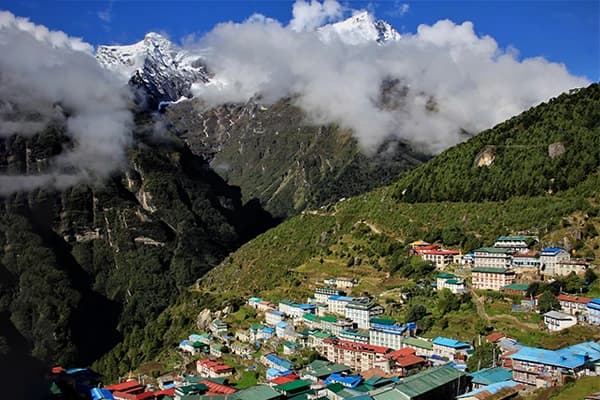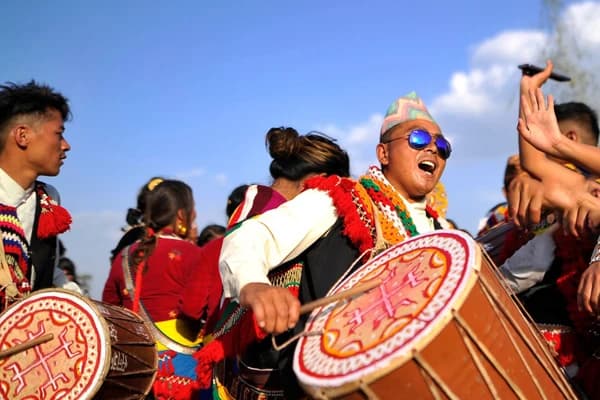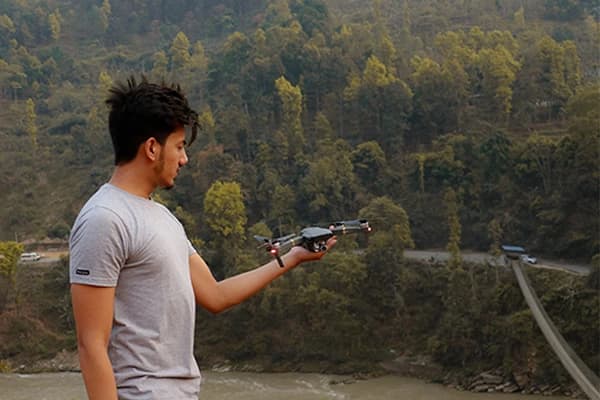Why do we celebrate Holi Festival or What is the story behind Holi?
The reason for celebration of the Holi is deeply rooted in the Hindu mythology. According to the Bhagavata Purana, the king Hiranyakashipu, a powerful demon king, was granted a boon that he could not be killed by any man or beast during the day or night, inside or outside, by any weapon.
This boon made him nearly invincible. So, he demanded everyone worship him as God. However, despite his father’s demand, Hiranyakashipu’s son remained devoted to Lord Vishnu. This angered the Hiranyakashipu, who ordered his demons to give him various types of punishments.
When all his powerful demons failed, he took the help of his sister Holika. Because Holika has received the boon to make her immune to fire when she wears a black cloak. So, she attempted to kill Prahlad by sitting with him on a heap of combustible material.
But things don't work out as planned because of divine intervention or Prahlad's devotion. At the time, a strong wind came and fly away the cloak from the Holika to Prahalad.
The Holika was burned instead of Prahlad. So, every year on the death ceremony of the Holika, the Holi festival is celebrated with the Holika puppet burning.
But, it is just the half answer. Many people still have a question like why do we celebrate the Holi festival in Nepal with colors. The answer is connected with the love story of Radha and Krishna.
Krishna was born with blue skin colors. He saw a girl named Radha and fell in love with her. But, Radha was of normal skin color. So, because of the difference in skin color, Krishna was afraid even to talk to her. The fear of losing Radha without talking to her was making Krishna sad.
Then, krishna's mother saw him sad and asked about the reason of being sad. Krishna answered about it. Then, it was his mother who suggested to put the color on Radha so, there will be no difference. Since then, the tradition of playing Holi with colors started.
Importance of Holi festival in Nepal
There is great importance of the Holi festival in Nepal. It marks the arrival of the new season, spring season, in Nepal. According to the legends, this connection to the weather is often called the victory of life over the cold and dark winter. The vibrant colors used in Holi celebrations are linked to the colors of the blooming flowers during the spring season.
The Holi festival is celebrated by all ages and backgrounds of the people in the Nepalese society. During the festival, people of all races gather together in one place to celebrate the festival. People don’t look at who is from their caste and who isn't. They simply enjoy the celebrations.
Holi Colors and Their Meaning
The Holi colors have their own symbolic meanings. Below are some of the common Holi colors and their interpretations are:
The color red symbolizes love, passion, bravery, and strength. It is often associated with the romantic story of Krishna and Radha.
The color yellow symbolizes happiness, sunshine, peace, and healing powers. Yellow is similar to turmeric so it represents the healing properties. The yellow color is often used in the ceremonies for its auspiciousness.
The color blue signifies calmness, serenity, courage, love, and infinity.
The color green represents nature's renewal during springtime.
The color pink embodies youthfulness and playfulness.
Orange represents courage and strength, while saffron is linked to spiritual growth.
Festivities and Rituals of the Holi Festival in Nepal 2026
The Holi festival is celebrated with various rituals and festivities. The festivities and rituals are described below.
Holika Dahan is an important ritual of the Holi celebration in Nepal. This ritual symbolizes the victory of good over evil. On the Holika Dahan night, a large bonfire is lit. Then, people gather around the bonfire for the rituals and prayers.
- Playful Games and Color Splashing
The playful games and color splashing are the most enjoyed parts of the Holi celebrations by the youths. It is played during the day time.
In this event, throwing colored powders (Gulal) and water balloons filled with colored water at each other is the main game. Almost all the people celebrate Holi by either throwing the color or the water balloons.
Various snacks and drinks are prepared and served during the Holi festival in Nepal. The common snacks and drinks include gujiya, sel roti, malai peda, dahi bhalla, malpua, bhang ladoos, lassi, and so on.
The music and dances make the festive atmosphere more vibrant and joyful. Some of the popular songs sung are Abiraya, Fagu Punhiya Holi, Holile Mero Rangayo Naya Choli and so on. The dances often include folk dances that reflect local traditions.
Differences in Holi celebrations in Terai and Hilly regions
The Holi festival is the most common festival here in Nepal, where people from any community or religion can easily come and participate.
When it comes to the hilly region, Basantapur always comes in first place. During the festival in 2026, the Holi starts from Basantapur with a long bamboo stick covered with several colorful pieces of cloth known as Chir and is erected along the Kathmandu Durbar Square.
The celebration starts further and continues to Thamel Street with a lot of colors, water, food, music, and dance. On this color festival day, people splash and rub dry colors on each other’s faces to express love and harmony, care, and blessings along with good wishes.
Alongside the street, people play beautiful colors, face paintings, water guns, balloons, and lots of music and dances. You can experience the whole environment filled with celebration, happiness, and joy.
Terai Holi is a bit different from the Hilly region. They play Holi on the next day in the Hilly region. In Terai, people gather in one place and they visit their relative's and friends' houses and wish them well.
They put holi colors on each other to convey their love, respect, and blessings. People organize parties at some point and enjoy music, food, dance, and fun as the part of their color festival celebrations.
Traditional Foods and Drinks during the Holi in Nepal 2026
The traditional food and drinks during the Holi festival play an important role in the festival celebrations. Some of the most popular foods and drinks that are prepared and eaten during the Holi festival are:
Gujiya is a deep-fried or baked sweet dish made from refined flour (maida) filled with a mixture of khoya (dried whole milk), grated coconut, and nuts like almonds or pistachios. It is specially prepared and eaten in the Terai region.
The Sel roti is a large, thin, puffed-up doughnut made from rice flour, sugar, ghee (clarified butter), water, and sometimes additional ingredients like fennel seeds or cardamom for flavor. Sell roti is a dish with a crispy exterior and soft interior. It can be found in most of the hotels around Nepal. This dish is also consumed during Dashain and tihar.
Malai Peda is a creamy ball made from the milk cream (malai) and garnished with dry fruits like almonds or pistachios. It can be of different colors and is eaten in most parts of Nepal, especially during the Holi festival.
Dahi Bhalla is fried lentil dumplings soaked in yogurt and garnished with various chutneys and spices. It is an international dish and can only be found in some places of the Terai districts, as it is not popular in cities.
Puri is deep-fried puffed bread made from wheat flour dough and aloo dum is a flavorful potato curry made from boiled potatoes with spicy tomato-based gravy. The puri accompanies the aloo dum while serving on the plate. It is the popular South Asian cuisine consumed during the Holi celebrations.
Mal Pua, also known as Malpuwa, is a deep-fried version of pancakes made from wheat flour, suji, sugar, and spices like cardamom and fennel seeds. It is sweet in flavor and appears golden brown in color with crispy edges.
Bhang Ladoos is a small sweet ball made by mixing the bhang paste or powder with ingredients like milk solids (khoya), sugar, ghee (clarified butter), nuts, and spices. This dish is popular, especially during festivals like Holi and Shivaratri. This may not be available in the hotels and restaurants but in local celebration places in the Terai and Pahad region.
Bhang lassi is a yogurt-based beverage often mixed with bhang (a liquid derivative of cannabis). It is made with bhang, yogurt, milk, sugar, and spices like cardamom or cinnamon. This drink is popular during festivals like Holi and Maha Shivaratri in places like Nepal and India.
Lassi is a yogurt-based drink that is made from whole milk yogurt, sugar, milk, cardamom powder, and chopped nuts. It can be of various types, like mango lassi, rose lassi and so on. This drink is consumed in most parts of Nepal during the Holi festival.
Popular Places to Experience the Holi Celebration in Nepal 2026
Almost all parts of Nepal celebrate this color festival in 2026. But like travel, there are few places where they organize holi festival in Nepal in such a way that everyone from across the country can come and celebrate like local people.
- Kathmandu Durbar Square, Patan Durbar Square, Thamel, and a few other places in Kathmandu are the most popular destinations for the Holi festival Kathmandu 2026.
- Pokhara, especially lakeside, is another popular destination for the holi event. If you are in Nepal, either you can stay in Kathmandu or you can go to Pokhara for the Holi festival.
- Several other Terai regions, like Nepalgunj, Dhangadhi, Janakpur, Birgunj, Jhapa, and other cities, are popular for Holi festival celebrations. They also organize the holi event.
Tips to participate in Holi festival celebration in Nepal
- Use sunglasses to protect your eyes from holi colors, water, and other playing things.
- Use proper and essential clothes so that you can avoid skin burns or harmful effects from chemical holi colors.
- If you have an allergy to colors, please do not play or just play with a few closed circles.
- Do not use watches, jewelry, and other expensive gadgets. It may get lost sometimes inside the crowd.
- The chemicals in the colors may cause skin rashes and allergies. So, as soon as you finish playing Holi, clean your skin and put on the necessary lotions.
- Use the organic holi colours for the holi celebration in Nepal as the chemical one may damage your skin.
- You can wear the holi clothes like white tshirt for the holi celebrations as the other clohes may be damaged by the colours.
- The holi celebration in kathmandu takes place in the different locations. Participate in those holi event to enjoy the festival of colours in.
- You can also buy the holi pichkari to splash the coloured water to your friends.
- Stay close to the group especially in the crowded groups like Basantapur and Thamel.
- Use the oil or lotion before celebrating the Holi festival 2026 as it is easier to remove the color after the holi event.
- Ask permission to the strangers before aplying the colors, especially to the girls or womens.
Final Words
Holi festival is a colour festival that offers an amazing experience for travelers to enjoy the Nepalese culture, lifestyle, and hospitality along with the essence of the festival. Whatever the belief behind this festival, the festival ultimately unites people together with their loved ones and helps to make their lives colorful.
The Holi Festival in Nepal for 2026 will be celebrated on the 2nd and 3rd of March. Most of the organizations celebrate the festival by buying holi gifts for employees.
Happy Holi 2026!





